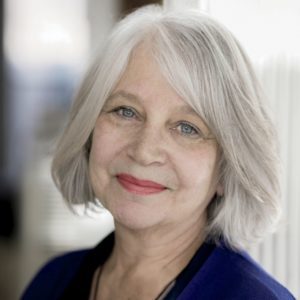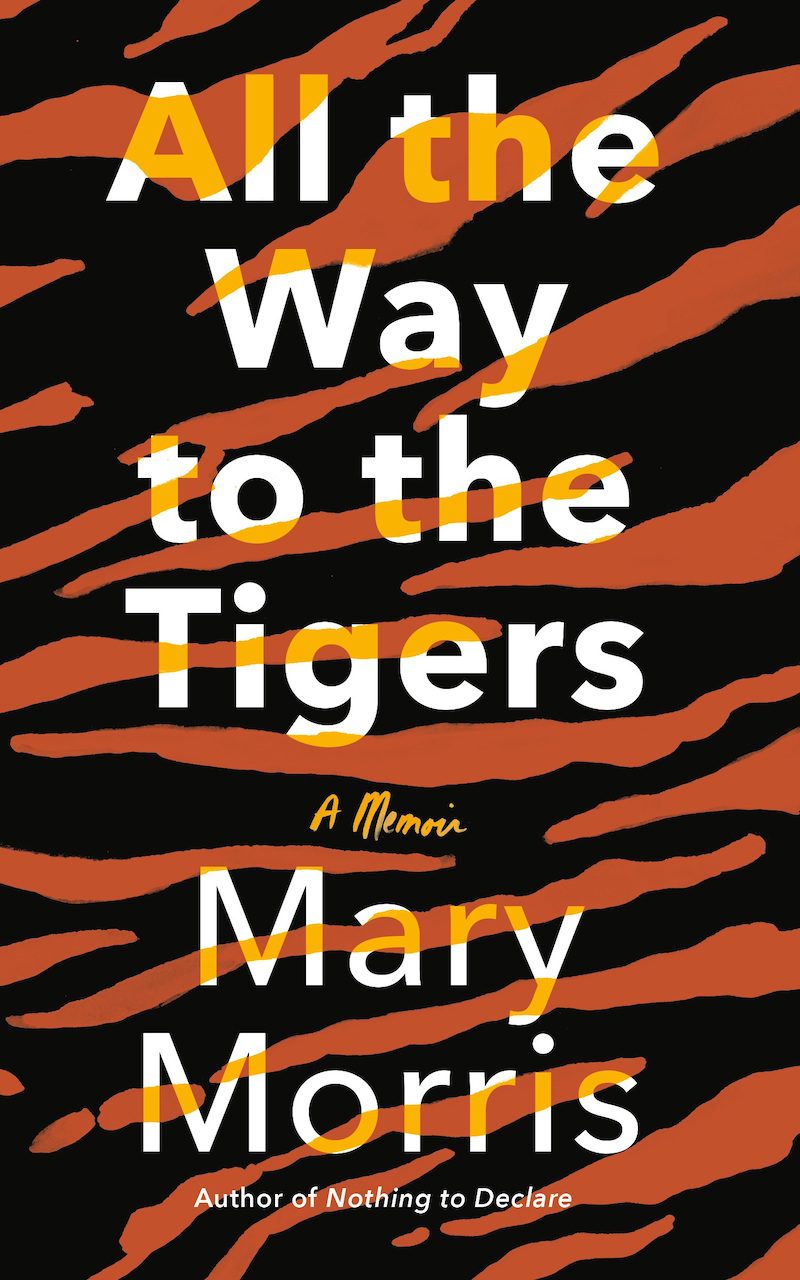
With her groundbreaking 1988 memoir Nothing to Declare, Mary Morris created a new and singularly feminist genre of travel writing. Mary loves to travel alone, and her travel memoirs center on the solo experience of journeys taken—in Central America, through Southern California, down the Mississippi River, and across Mongolia from Beijing to Berlin. Now the series continues with All the Way to the Tigers, a newly published chronicle of Mary’s search for tigers in India and of her quest to understand the elusive and solitary spirit within that propels her on her many journeys through the world alone.
During our conversation, Mary hinted that this might be the last title in her solo travel series, but that won’t make a dent in her literary momentum. She is also a prolific fiction writer. Her many acclaimed novels include Gateway to the Moon and The Jazz Palace, for which she was awarded the 2016 Anisfield-Wolf Award in fiction, as well as three story collections.
Given Morris’s background, it seemed natural to discuss how we tell different types of stories and how her structural approach shifts when moving from fiction to memoir.
***
The Rumpus: All the Way to the Tigers is your fifth solo travel memoir, and like the others, it weaves together the inner and outer journeys in a very purposeful way. In this book, the interior story involves your recovery from a brutal injury, but it also has a great deal to do with your parents. By the end, both the inner and outer journeys resonate as intrinsic elements of the overarching story of your quest to sight a tiger in India.
So, my first question is: at what point do you identify the interior journey that will run through your memoirs? Is it the circumstance that propels you to take a particular trip, or is it a thread that you only discover through the process of writing?
Mary Morris: It is definitely a thread that I only discover through the process of writing. I never set out saying, here’s my inner journey and how does it connect to the actual journey I am taking. In this book, for example, I knew that I wanted to go to India and look for tigers, but I had no idea that it would enable me to write about some things I’ve never written about before, such as my father’s anger. It’s a very organic process really. When I learned that tigers are afraid of anything white (because whiteness does not exist in their world) and that the maharajas flushed tigers out of the jungle by sewing sheets together, I started to think about the writer and the whiteness of the blank page, and then I remembered about that moment when my father taught me how to write my name. So it’s not linear. I write the same way I travel. Basically, with no itinerary, no road maps. Detours are always welcome.
Rumpus: Fascinating! This reminds me of the famous Doctorow quote: “Writing is like driving at night in the fog. You can only see as far as your headlights, but you can make the whole trip that way.”
Morris: I’ve always loved that Doctorow quote. It’s so true.
Rumpus: You’ve said that you see your memoirs as having more of an arc than a plot. Could you elaborate on that?
Morris: Well, this might get us in the weeds here a little, but I think it’s a matter of degrees. Basically, to me a story is made up of scenes, and if you string enough scenes together, especially those that might surprise the reader (and hopefully will!), you’ll have a plot which is linear. One incident leads to the next. This seems true to me in most novels— at least the ones that I enjoy. But an arc is different. You still have the same sense of the story moving forward, but it is more character driven than scene driven.
When I am writing fiction, I am always scene-driven. A leads to B and B leads to… who knows? But the travel writing, in which I am always, for better or worse, the main character in my own story, is about an arc. What mistake is Mary going to make today and where will that take her? Think of a rainbow (in French, un arc en ciel). It has that arc, and it is the journey. A beautiful arc is satisfying, but it doesn’t mean you’re going anywhere. It won’t have the inevitability of a plot.
Rumpus: It seems to me that you’re describing two different paths to discovery. In plots, discovery and insight are reached through events that force characters to make choices and change. In the arc that you’re describing for memoir—and certainly in the arc that unfurls in this memoir—discovery and insight are reached through the associations you make between present and past. It’s not what happens that matters, as it would in a novel, so much as the way you, Mary, process what happens. Do I have this right?
Morris: In terms of plot and arc, yes I think the way you’ve rephrased it makes perfect sense.
Rumpus: I wonder if you’d share with us some of the travel memoirs that have guided you in this realm?
Morris: I’ll be perfectly honest. When I began to write about my travel experiences (Nothing to Declare was published in 1988), contemporary women weren’t really writing about their travel experiences. There were, of course, the classic lady travelers—mostly women of means and little or no domestic responsibilities—and I read and admired those writers such as Willa Cather and Edith Wharton, who wrote so eloquently about their travels, and Mary Wollstonecraft (mother of Mary Shelley), who sadly died in childbirth but was a fabulous writer who was not afraid to hide her emotions, such as how much she missed her infant daughter, Fanny, when she was traveling in the North. But when I began, my contemporaries were almost exclusively men, such as Paul Theroux, Bruce Chatwin, Jack Kerouac, and Peter Matthiessen, and what I realized was that as a woman, I moved through the world differently than these men. For better or worse my experiences seemed to me more personal and subjective. I wanted the reader to know who I was. My outer journey was reflected in my inner journey. In other words, not to denigrate these fine writers, but reading them taught me what I didn’t want to do.
I will add that my husband and I did edit together an anthology of the travel of women, entitled Maiden Voyages. We wanted the female voice on the road to be heard more.
Of course, since then there have been wonderful travel memoirs by women. I think Wild by Cheryl Strayed is my favorite, but this was written long after I began.
Rumpus: I distinctly remember when Nothing to Declare was published, and I was so envious of the moxie it took for you to travel internationally on your own. I didn’t even think of the courage it took to generate a whole new form of travel writing! The net result, of course, is a distinctly feminist model for life and art. Which brings me to the tiger as the foundational symbol in your new memoir.
Dreams play an important role in this book, and the tiger seems to have been a recurring visitor in your childhood dreams. Also, a series of coincidences in Paris kept leading you to images of tigers that seemed to portend your trip to India. There also are quotes from Borges and Thomas Mann that nudge you “to the tigers,” but the revelation that strikes me as most important is introduced in the very first pages: “All unseen tigers are referred to as ‘she’.” Could you tell us what it was about tigers that summoned you to India, and what they came to represent through the journey and the writing of this book?
Morris: Well, I think basically this is what the book is about and so, though I hate to answer your question in this way, I might have to say, read the book. The story of the tigers—real, imagined, elusive, dreamed about, and even as metaphor—this is what has preoccupied me for decades and what I spent a dozen years thinking and writing about for purposes of this book.
Rumpus: Fair enough! It’s like the story about Isadora Duncan. When a man asked her to describe her dance, she replied, “If I could tell you what it meant, there would be no point in dancing it.”
Let’s shift back to the physical art of travel writing, then. Could you offer some insights, tips, warnings about writing on the road as a solo traveler? Because you are a woman, that inevitably includes issues related to traveling as a woman alone, but I’m actually more interested in your process of journaling. What do you look for? Are you constantly scribbling, or do you curate your observations at the end of each day? Do you attempt to “make sense” of it in your journal, or do you simply concentrate on the raw material in the moment?
Morris: Well, in terms of travel tips, my best advice is, follow your gut. If something seems dicey, it probably is. If you don’t feel safe, you probably aren’t. Just do what your mother taught you (“Don’t take candy from strangers”), and you’ll be fine.
As to the process of journaling, it depends a bit on the kind of journey I’m on and the kind of day I’m having. Ideally, I like to write in my journal almost in real time. I am pretty much constantly taking notes. I try to travel with a small journal that fits easily into a pouch I always wear when I’m traveling. Wallet, phone, journal, pen. I also usually have a watercolor kit (very small) and a glue stick (my journals also can be kind of scrapbooks). Anyway, it must all fit into the pouch.
But I also travel with reporters’ notebooks. You know, the skinny spiral kind. For certain projects I might need to do interviews, or it’s just a lot easier to scribble and then transcribe into my journal. Call me old-fashioned, but I never journal electronically. First of all, for the practical reason that often there’s no electricity, or just for fear I’ll lose everything. And then for the artistic reason, which is that I primarily write by hand. I have this crazy theory that the hand is the end of the brain. I mean, neurologically, it kind of is. To really write, I need to hold a pen.
***
Photograph of Mary Morris by Zoe Fisher.





